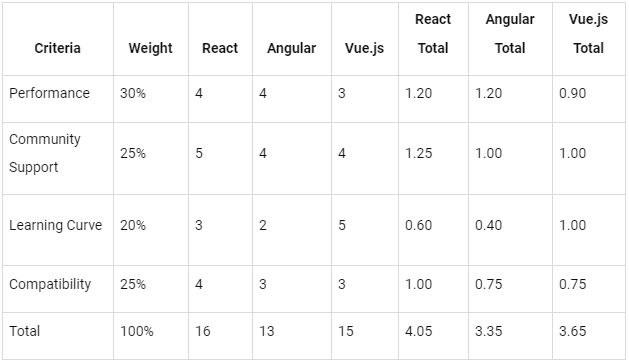Navigating Choices in Software Development: The Power of a Decision Matrix
In the complex world of software development, making informed and efficient decisions is crucial. This is where a Decision Matrix becomes an invaluable tool. At James Anthony Consulting (JAC), we advocate for the use of Decision Matrices to streamline decision-making processes in software projects. Let's dive into what a Decision Matrix is, how to use it, some best practices, and provide a practical example.
What is a Decision Matrix?
A Decision Matrix, also known as a Prioritisation Matrix or a Pugh Method, is a tool used to evaluate and prioritise a list of options against a set of criteria. In software development, it assists in making decisions like choosing between different technologies, methodologies, or features.
How to Use a Decision Matrix in Software Development
Identify Your Options: List all potential choices. For instance, selecting a programming language for a new project.
Determine Criteria: Establish the criteria important for the decision. This could include factors like cost, scalability, team expertise, and community support.
Weigh the Criteria: Assign weights to each criterion based on its importance. This prioritises certain factors over others.
Rate Each Option: Evaluate how each option fares against the criteria on a scale (e.g., 1-5).
Calculate Scores: Multiply the ratings by the weights and sum them up to get a total score for each option.
Analyse Results: The option with the highest score is typically the most suitable choice.
Best Practices and Tips
Stay Objective: Keep personal biases out to ensure a fair assessment.
Involve the Team: Include team members in the process for diverse perspectives.
Review and Revise: Be open to revising the matrix as new information arises.
Simplicity is Key: Don’t overcomplicate the criteria. Keep it straightforward and relevant.
Example: Selecting a Front-End Framework
Imagine you’re choosing a front-end framework for a new web application. Your options might include React, Angular, and Vue.js. Your criteria could be performance, community support, learning curve, and compatibility with existing systems. Assign weights and rate each framework against these criteria. Sum up the scores to see which framework is the most suitable for your project needs.
Creating a Decision Matrix example for the scenario of selecting a front-end framework involves a few steps. First, we'll define the options (front-end frameworks) and the criteria for evaluation. Then, we'll assign weights to the criteria based on their importance and rate each framework against these criteria.
Let's say our options are:
React
Angular
Vue.js
And our criteria with assigned weights might be:
Performance (Weight = 30%)
Community Support (Weight = 25%)
Learning Curve (Weight = 20%)
Compatibility with Existing Systems (Weight = 25%)
Each framework will be rated against these criteria on a scale of 1 to 5 (1 = Poor, 5 = Excellent).
Let's create this matrix:
In this matrix:
Each framework (React, Angular, Vue.js) is rated against the criteria (Performance, Community Support, Learning Curve, Compatibility) on a scale of 1 to 5.
The Total score for each framework is calculated by multiplying each criterion rating by its weight and summing these up.
The framework with the highest total score is considered the most suitable choice based on the given criteria and weights.
In this hypothetical example, React scores the highest total (4.05), suggesting it might be the most suitable choice based on the defined criteria and weights. However, these ratings are illustrative and should be tailored to the specific context and requirements of the project.
Conclusion
At JAC, we believe that a Decision Matrix is a simple yet powerful tool for making objective and well-informed decisions in software development. It brings clarity and structure to the decision-making process, ensuring that choices align with project goals and constraints. By following these guidelines and incorporating a Decision Matrix into your workflow, you can enhance the efficiency and effectiveness of your software development decisions.
For more insights and expert guidance in software development, stay tuned to James Anthony Consulting’s blog.


